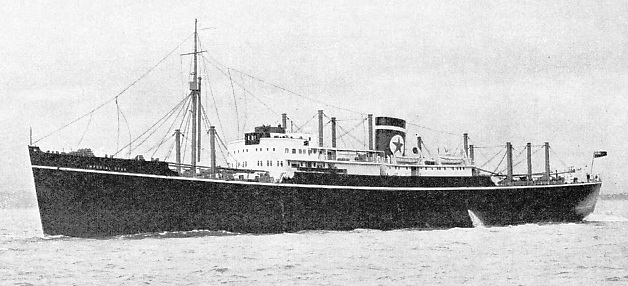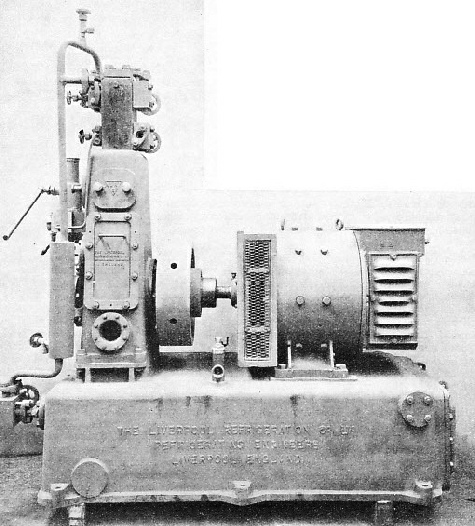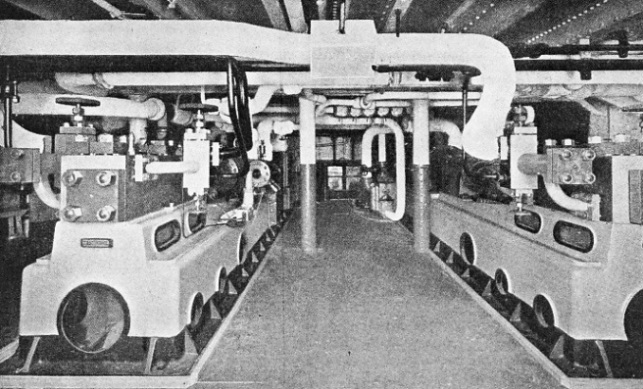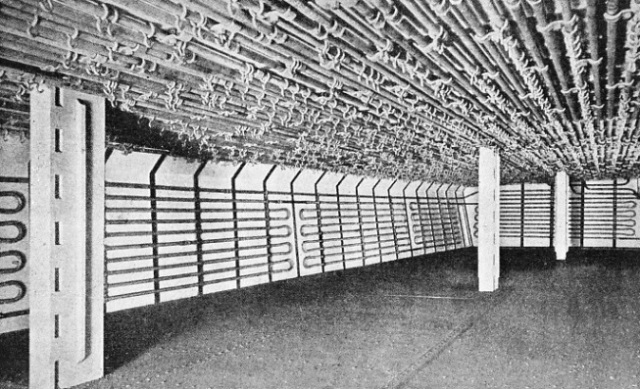

© Shipping Wonders of the World 2012-

Refrigerated Ships
Elaborate precautions have to be taken to preserve in good condition chilled or frozen meat and provisions carried over long distances. Specially built ships of interesting design are used on these routes
ROMANCE OF THE TRADE ROUTES -

TWENTY-
DURING the last fifty years the refrigerated ship has changed conditions of life for millions of people, especially those who live in crowded industrial countries such as the British Isles, in primarily agricultural and farming countries overseas such as Australia, New Zealand, South Africa and the Argentine, and in many tropical countries. Thanks to the steam and motor ship, to the research scientist and the engineer, our transport of perishable foodstuffs, particularly meat and fruit, has made immense strides in recent years.
For ages the ship has been the great instrument that civilized peoples have used to counter possible famine. Lack of scientific knowledge, however, and the slowness and uncertainty of sail prevented the efficient transport of food that tainted quickly. Non-
the port of Rome. To this day dried or cured fish is consumed in large quantities by Latin peoples, and Newfoundland schooners still trade across the Atlantic and down the American seaboard to the West Indies and Latin America; but the science of carrying fresh meat and fruit across the sea made little progress from ancient times to the 1870s, when the clippers raced home from China with tea.
Pickling in brine was the chief method of preserving food on land and at sea. Those who made long voyages gave up hope of dainty meals as soon as the coast dropped below the horizon. Live chickens, and often a cow, were carried to alleviate the hardships of ocean travel, and on special voyages animals and seeds were taken by sailing ships to newly discovered lands to propagate the herds and crops that now flourish. It was not possible in those days to transport thousands of tons of meat and fruit in prime condition from one side of the world to the other.
The problem of preserving food, however, did much to help the development of shipping. Spices were needed to preserve meat and to disguise the taste of food that was no longer fresh. The spices carried to Europe by the early merchant adventurers fetched high prices. When South America, Australia and New Zealand began to develop as cattle-
These countries were limited to the consumption of local fruits and of oranges or similar fruits that could survive a short sea voyage. Thus, except when there was a glut, fruit was a luxury beyond the means of poor people, and the possibility of being able to eat fresh fruit all the year round seemed fantastic and against the laws of Nature. People would have laughed at the idea of buying for a penny an apple that had been brought 12,000 miles to market.
If it were not for the work of the food ships the inhabitants of Great Britain would starve. Grain and beverages such as tea, coffee and cocoa do not require refrigeration or the newer methods of gas-

ELECTRICALLY DRIVEN VERTICAL COMPRESSOR of the type often used in refrigerated ships. This type has the advantage of compactness as the condenser is incorporated in the bedplate. Carbon dioxide (CO2) gas is used as the refrigerant, and brine circulated through pipes in the holds produces the right degree of temperature.
Food preservation with natural ice has been known for centuries. Ice was imported into Great Britain in large quantities during Queen Victoria’s reign and up to 1914, when war compelled the British to rely upon refrigeration plants. Natural ice was tried as a food preservative in sailing ships, but it was not successful because the ice thawed too quickly. The rapid growth of the population and the continued scarcity of meat became a serious problem in the middle of the last century. Salted beef and pork and canned beef and mutton were imported and cattle were shipped alive from America. It was impossible to ship live cattle from the Antipodes because the distance was so great and consequently the freight charges were high.
There were many set-
The first successful shipment of meat under chemical refrigeration was carried by the S.S. Paraguay from Buenos Aires to Rouen in 1877. The news was telegraphed to Australia, and Queensland farmers instituted an inquiry. Then the S.S. Strathleven was fitted with refrigerating machinery and insulation. Meanwhile, in 1879, the Anchor liner Circassia, equipped with a cold storage machine, had successfully carried chilled meat from America to Europe.
Fresh After Ninety-
The Strathleven sailed from Sydney, called at Melbourne, and reached London on February 2, 1880, with the first shipment of frozen meat from Australia. The cargo was small but its importance was realized in Great Britain and Australia. About 40 tons of beef and mutton costing from 1½d to 2d a pound in Australia fetched, at Smithfield Market, London, from 4½d to 5½d a pound for the beef and from 5½d to 6d a pound for the mutton. Queen Victoria and the Prince of Wales (afterwards King Edward VII) accepted joints from this consignment. This was regarded as the beginning of the frozen meat trade.
At the end of 1880 a consignment of more than 4,500 sheep and lamb carcasses and 100 tons of butter reached London in the Protos at a time when London’s supplies were failing because of severe snowstorms. Then the Europa was fitted out for the new business, and in 1881 the Orient Line took up the trade. Its steamships Cuzco, Orient and Garonne brought large consignments from Australia.
New Zealand began her trade in 1882 by sending frozen sheep in the Shaw, Savill and Albion sailing vessel Dunedin. She took ninety-
At first there were good reasons for the shipowners’ hesitation. Of the 17,000 sheep sent from Australia in 1881 rather fewer than one-
For a long time beef from Australasia was unsatisfactory until low-
The refrigerating plant of the early days, operated from the main boilers, reduced the ship’s speed and sent up coal consumption by an appreciable amount. This made a corresponding addition to the coal bill, especially if the vessel were bound home via the warm Indian Ocean and Suez Canal route. If she went round Cape Horn (the Panama Canal was not built) and spent more time in cooler waters, she did not need to run her refrigerating plant for so long.
Vital Temperatures
Frozen meat requires to be kept at 12° to 15° Fahrenheit, chilled meat at 29°, with no more than a ½° degree variation on either side of the nominated temperature. Fruit requires various temperatures, pears being carried at about 29°, apples at 32° to 33°, oranges at 35° to 45° and bananas at 54°.
Fruit is generally carried in chambers fitted with forced air circulation, and frozen and chilled meats in chambers cooled by pipe grids on the walls and overhead.
A refrigerated ship generally carries engineers who have nothing to do with the operation of the vessel, but who are concerned solely with the condition of the perishable cargo of food. Should a vessel meet with a mishap, one of the first things the underwriters ascertain is whether her refrigerating plant is working. If the storage plant is not functioning, the cargo, worth thousands of pounds, will be ruined. The temperature of a hospital patient on the danger list is not more carefully charted than the temperature of the refrigerated cargo of a ship.
Time is vital, particularly with fruit, and modern fruit carriers are much faster than general cargo ships. Liners on the Australian route carry meat cargoes. So rapidly does meat decompose in the tropics that, were it economically possible to transport unrefrigerated fresh meat from Australia to Great Britain by air, the meat would decompose on the flight through the torrid zone. Refrigeration is the only possible method. The weight of the plant at the time of writing rules out the possibility of air transport.

DUPLICATE PLANT is installed in the Blue Star liner Almeda Star. Either set of machinery is capable of maintaining the necessary temperatures throughout the ship. Either of the refrigerating machines consists of a tandem compound steam engine driving from its tail rod a CO2 gas compressor, having a cylinder diameter of 7½-
The transport of fruit presents more difficulties than the transport of meat. Even to-
Fleets of specially designed ships are devoted solely to the shipment of bananas. Hundreds of millions of bands (bunches) of bananas are shipped annually in specially built vessels from tropical America, the West Indies and the Canary Islands to the United Kingdom, the United States, and the Continent. The French have vessels to bring the fruit from their colonies in the West Indies and Africa, and the Germans have built ships for bringing bananas from German-
Bananas are cut, when they are green and hard, in hands of about a hundred bananas attached to the stalk. The whole operation of cutting and marketing the banana is carefully timed. Some companies have their own plantations in the tropics, their own fleet of refrigerated ships and their own marketing organization. The plantation manager is informed beforehand when a vessel is due, and arranges for the fruit to be cut and ready directly the ship arrives. Then the bananas are placed in the insulated and ventilated holds and are inspected at intervals during the voyage.
Vessels built for the banana trade are equipped with refrigerating machinery and fans for circulating large volumes of air over brine-
Some Fast Fruit Carriers
Speed is essential for these fruit carriers, and as many of them go direct to small ports in the tropics where big liners do not call, they have accommodation for about a dozen passengers. In recent years British and Continental shipyards have specialized in the construction of refrigerated fruit-
To-
Fruit carriers do not rival in size the ships engaged in the meat and fruit trade with South America, such as the Blue Star motor liner, Tuscan Star, of 11,449 tons. She has seven large holds with forty-
The successful carriage of meat and certain fruits has caused an economic revolution, but much remains to be discovered. Every step forward means the opening of new markets for the producer, and the introduction of a wider variety of food to the consumer.

BRINE PIPES AND MEAT RAILS in one of the ’tween deck chambers of the Blue Star liner Almeda Star. This vessel has no fewer than forty-
You can read more on “Filling the Ship”, “Fruit Carrying Ships” and
“The Klipparen” on this website.